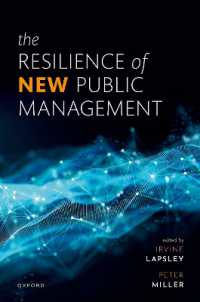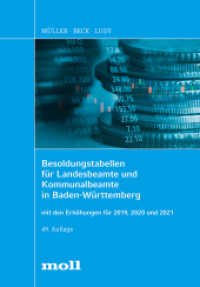Full Description
Addressing the immensely important topic of research credibility, Raymond Hubbard's groundbreaking work proposes that we must treat such information with a healthy dose of skepticism. This book argues that the dominant model of knowledge procurement subscribed to in these areas—the significant difference paradigm—is philosophically suspect, methodologically impaired, and statistically broken. Hubbard introduces a more accurate, alternative framework—the significant sameness paradigm—for developing scientific knowledge. The majority of the book comprises a head-to-head comparison of the "significant difference" versus "significant sameness" conceptions of science across philosophical, methodological, and statistical perspectives.
Contents
1. Introduction
2. Philosophical Orientation - Significant Difference
Introduction
Conception of Knowledge
Model of Science - Hypothetico-Deductivism
The Role of "Negative" (p>.05) Results
Conclusions
Appendix: An Empirical Regularity Not to be Proud Of
3. Philosophical Orientation - Significant Sameness
Introduction
Conception of Knowledge
Model of Science - Critical Realism
The Role of "Negative" (P>.05) Results
Statistical Power of "Negative" (P>.05) Results
Conclusions
4. The Importance of Replication Research - Significant Sameness
Introduction
A Succinct Overview of Replication's Role
A Typology of Replications
Replication Research and the Acquisition of Knowledge
The Role of "Internal" Replications
Conclusions
Appendix: The Use of Student Samples in the Management and Social Sciences
5. The Importance of Replication Research - Significant Difference
Introduction
The Publication Incidence of Replication Research in the Managerial and Social Sciences
The Outcomes of Replication Research
The Timeliness of Replication Research
Why the Lack of Replication Research?
The Publication Frequency of Critical Commentary
Conclusions
6. Conception of Generalization/External Validity
Introduction
Significant Difference
Significant Sameness
Conclusions
Appendix: Fisher's Views on Probability and Random Sampling
7. Contrasts Over Statistical Issues
Introduction
Model Uncertainty
Nature of Predictions Made
The Role of P-Values
The Role of Effect Sizes and Confidence Intervals
Conclusions
8. Whither the Academy?
Introduction
Obstacles to the Implementation of the Significant Sameness Paradigm
Cultivating a Significant Sameness Tradition
Retrospective: Empirical Regularities and the Emergence of Nineteenth Century Social Statistics and Social Science
Conclusions
9. Epilogue








